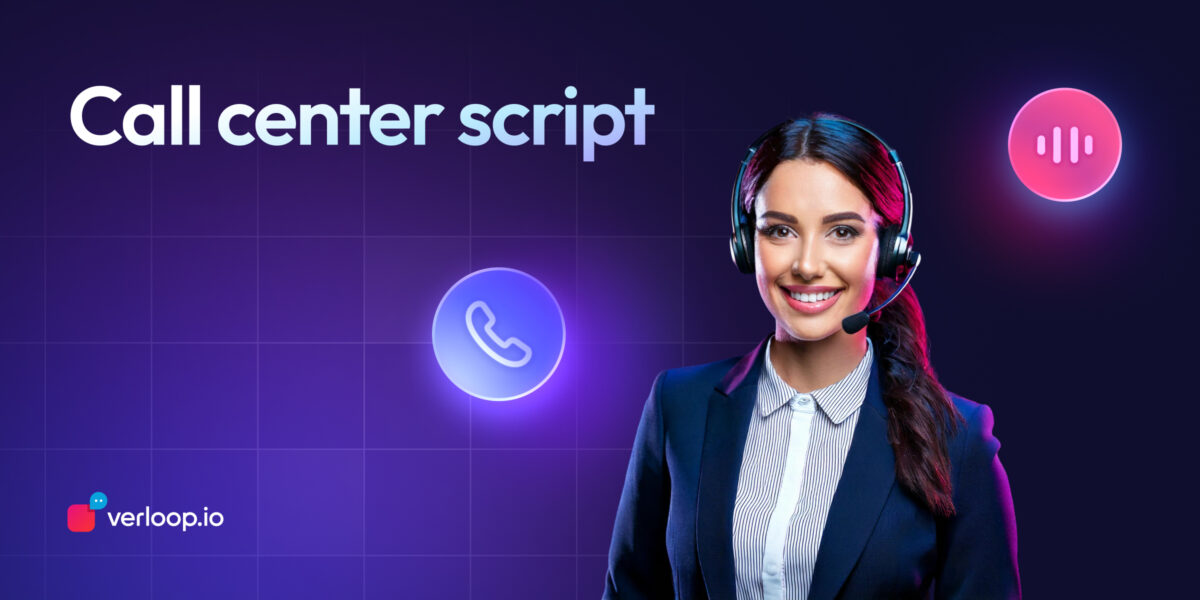Effective Call Center Scripts for Success
- August 12th, 2025 / 5 Mins read
-
Aarti Nair

Effective Call Center Scripts for Success
- August 12th, 2025 / 5 Mins read
-
Aarti Nair
Understanding Call enter Script
Call centre interactions are a crucial touchpoint for businesses, where the quality of communication can make or break customer satisfaction. Consider the experience of a customer who calls for the third time in a week about the same issue—they’ve already spent considerable time navigating the system, and the frustration is mounting. The way an agent handles this call can significantly impact the customer’s perception of the business.
Effective call center scripts play a critical role in maintaining consistency, improving the efficiency of responses, and ensuring customer satisfaction. This is particularly essential when you consider that industry benchmarks for escalation rates typically range from 2-5% for inbound call centres and 5-10% for technical support centres. By using well-crafted scripts, businesses can minimise these escalation rates, improve the customer experience, and ultimately enhance their brand’s reputation.
This blog will provide you with practical tips, templates, and examples for both inbound and outbound call centre scripts to help you streamline operations and ensure quality interactions with every customer.
Types of Call Center Interactions
Understanding the different types of call centre interactions is key to crafting effective call centre scripts. Each interaction type requires a specific approach to ensure that the customer’s needs are met efficiently and effectively. Below are the main types of call centre interactions you should consider when developing your call centre scripts:
1. Inbound Calls
Inbound calls are the most common type of call center interaction, where customers initiate contact with the call center to inquire about products, services, or resolve issues. The primary goal in inbound calls is to provide fast, accurate, and friendly service. These calls can vary greatly depending on the issue at hand, from basic inquiries to complex technical support issues.
Best Practices for Inbound Calls:
Greet customers promptly and warmly.
Understand the purpose of the call quickly to direct the customer effectively.
Use clear, concise language to explain solutions and ensure understanding.
Always ask follow-up questions to ensure resolution.
Offer solutions or escalate if necessary.
2. Outbound Calls
Outbound calls involve call center agents reaching out to customers for various purposes, such as sales, surveys, reminders, or customer service follow-ups. This type of interaction typically requires agents to be proactive, persuasive, and well-prepared for any objections or concerns.
Best Practices for Outbound Calls:
Start the call with a polite introduction and clearly state the purpose of the call.
Be mindful of the tone and pace of your speech to ensure the customer feels heard.
Use open-ended questions to guide the conversation and gather the necessary information.
Always be ready with relevant information, especially for follow-up calls.
End the call with a clear call to action or next steps.
3. Technical Support Calls
Technical support calls are often complex, requiring specialised knowledge and problem-solving abilities. Customers who call for technical support typically expect quick and efficient solutions. These calls often involve troubleshooting, product issues, or technical guidance.
Best Practices for Technical Support Calls:
Be empathetic and patient, as technical problems can be frustrating for customers.
Ask clear diagnostic questions to get to the root of the issue.
Offer simple, step-by-step solutions, and avoid jargon to ensure the customer can follow along.
Confirm resolution before ending the call to avoid future escalations.
4. Emergency or Critical Support Calls
These calls often arise in high-stakes situations, such as system outages, service interruptions, or urgent troubleshooting needs. The customer may be highly stressed, requiring the agent to maintain calm and professionalism under pressure.
Best Practices for Emergency Support Calls:
Acknowledge the urgency of the situation to reassure the customer that their issue is a priority.
Keep the customer informed at every step of the process.
Provide clear instructions and, if necessary, escalate immediately to the appropriate department.
Follow up after resolution to ensure customer satisfaction and prevent future issues.
5. Sales Calls
Sales calls are aimed at generating new business or following up on leads. The call center agent’s goal is to pitch products or services, overcome objections, and close sales, all while maintaining a positive customer relationship.
Best Practices for Sales Calls:
Start by identifying the customer’s pain points or needs.
Provide tailored solutions that match the customer’s requirements.
Handle objections with empathy and confidence, using positive language.
Ensure the customer is fully aware of the value they’ll get from the product or service.
Always close the call with a strong call to action.
By identifying the type of interaction and using scripts tailored to each scenario, you can optimize the customer experience, ensure smooth communication, and drive better outcomes for both customers and the business. In the next section, we’ll dive into the specifics of creating inbound and outbound call centre scripts.
Key Components of Inbound Call Scripts
Inbound call scripts are essential for ensuring that every interaction is handled professionally, efficiently, and with a focus on customer satisfaction. By following a well-structured script, call centre agents can provide consistent, high-quality service while meeting the needs of the customer. Below are the key components of an inbound call script.
1. Greeting the Customer
The first step in any inbound call script is the greeting. This sets the tone for the rest of the interaction and is critical in creating a positive customer experience. A polite and professional greeting lets the customer know they are valued. For instance, when a customer calls to inquire about a service, the greeting could be:
“Good morning! Thank you for calling [Company Name], how may I assist you today?”
This simple greeting offers immediate assistance, putting the customer at ease while also creating a welcoming atmosphere.
2. Identifying the Customer’s Needs
Once the customer has been greeted, the next step is to identify their specific needs. This involves asking the right questions to gather the necessary information to provide an appropriate solution. For example, if a customer calls with a billing issue, an agent might ask:
“Can you please confirm your account number so I can pull up your details and assist you further? Could you also let me know the issue you’re experiencing with your bill?”
By gathering this information early on, the agent can quickly determine how to resolve the issue.
3. Providing the Solution
After understanding the customer’s problem, the next step is to provide a solution. The agent should be clear, concise, and confident when presenting the resolution. For example, if the customer is calling about a billing issue, the agent might respond:
“I’ve reviewed your account, and I can see that there was an error in the system. I’ll fix it for you right now by updating your settings. It should take just a minute, and I’ll send you a confirmation email once it’s resolved.”
This clear and straightforward response reassures the customer that their issue is being taken care of efficiently.
4. Closing the Call
The final step in the inbound call script is closing the call on a positive note. This involves summarising the conversation, confirming that the customer’s needs have been met, and offering any next steps or additional assistance. For example:
“I’ve updated your account settings as requested. Is there anything else I can assist you with today? No? Great! I’ll send you a confirmation email shortly. Thank you for calling [Company Name], and have a wonderful day!”
By closing with a clear, positive statement, the agent leaves the customer with a sense of satisfaction and certainty.
Each of these key components — greeting, identifying needs, providing solutions, and closing the call — ensures that inbound calls are handled smoothly and efficiently. A well-crafted inbound call script not only resolves the customer’s issue but also creates a positive experience that enhances overall satisfaction. By incorporating these components into your call centre scripts, your team will be equipped to handle customer interactions effectively, boosting both customer loyalty and operational efficiency.
Creating Inbound Call Centre Scripts
Inbound calls require agents to quickly understand customer needs and provide effective solutions. A well-crafted inbound call center script ensures that agents maintain consistency, efficiency, and professionalism during these interactions. Here’s a breakdown of how to structure an inbound call center script:
1. Greeting and Introduction
The greeting sets the tone for the entire interaction. A warm, welcoming, and professional introduction can instantly put customers at ease and make them feel valued. This is also where you confirm the customer’s identity or gather relevant details to assist them.
Sample Script:
Agent: “Hello, thank you for calling [Company Name], this is [Agent’s Name], how can I assist you today?”
Customer: [Customer’s inquiry]
Agent: “I’d be happy to help you with that. May I have your name and account number, please?”
2. Understanding the Customer’s Issue
Once the customer’s information is verified, the next step is to identify the problem clearly. Ask open-ended questions that encourage the customer to explain their issue in detail.
Sample Script:
Agent: “Can you please tell me a bit more about the issue you’re experiencing?”
Agent: “When did the problem first occur?”
3. Addressing the Problem
Once the issue is understood, provide a solution or direct the conversation toward troubleshooting. Be clear, concise, and confident in your responses. If the issue requires further escalation, assure the customer that their problem will be addressed promptly.
Sample Script:
Agent: “I see the issue. Here’s what we can do: [Solution].”
Agent: “If this doesn’t resolve the issue, I will connect you to our specialist who can further assist you.”
4. Confirming Resolution and Closing the Call
Before closing the call, always confirm that the customer’s issue has been resolved. This gives them the opportunity to ask follow-up questions, ensuring they feel heard and understood. Thank them for their time and assure them of your continued support.
Sample Script:
Agent: “Is there anything else I can assist you with today?”
Agent: “Thank you for calling [Company Name]. We appreciate your business. Have a great day!”
Key Tips for Inbound Call Center Scripts
Inbound calls are typically reactive, with customers reaching out for assistance or with inquiries. A well-structured inbound call script helps ensure that calls are handled efficiently and professionally, leading to high customer satisfaction and effective issue resolution. Here are some key tips to make sure your inbound call scripts are optimally designed:
1. Personalisation: Use the Customer’s Name to Build Rapport
Personalization is one of the most powerful tools an agent has for building trust with a customer. By using the customer’s name, the agent can create a more friendly, conversational atmosphere that helps put the customer at ease.
Example: “Good afternoon, Mr. Smith. How can I assist you today?”
This simple use of the customer’s name helps make the interaction feel more human, which can significantly improve the customer’s experience.
2. Clarity: Avoid Jargon, Especially When Explaining Solutions
It’s easy to fall into the trap of using technical terms or company-specific jargon when you’re familiar with your product or service. However, doing so can confuse or frustrate customers who may not be as knowledgeable. Ensure that your script encourages clear, simple language that’s easy for the customer to understand.
Example: “I understand this might be confusing, so let me explain it step by step…”
This approach makes the customer feel heard and ensures that the solution is communicated in a way that’s accessible to them.
3. Empathy: Acknowledge the Customer’s Frustration or Concern
When a customer calls in, they might be experiencing a problem, frustration, or dissatisfaction. Acknowledging their emotions with empathy can go a long way in calming the situation and making them feel understood.
Example: “I can see how that would be frustrating. Let’s get this resolved for you right away.”
Empathy not only helps in building rapport but also reassures the customer that you are there to help and understand their situation.
4. Positive Language: Use Positive Language to Create a Solution-Focused Atmosphere
Positive language focuses on finding solutions rather than dwelling on problems. It is essential in inbound call scripts as it can turn a potentially negative experience into a positive one. Avoid negative or blaming words like “I don’t know,” or “That’s not possible,” and replace them with positive alternatives.
Example: “I’ll be happy to assist you with that issue and have it sorted out quickly.”
This creates a positive atmosphere, fostering goodwill and making the customer more receptive to the support being offered.
5. Efficiency: Keep the Script Structured but Flexible
While it’s essential to have a structured script to ensure that all necessary information is gathered and steps are followed, it’s equally important that the script is flexible enough for agents to adapt their responses based on the customer’s unique needs. A rigid script can feel robotic and impersonal, while a flexible one allows agents to provide a more tailored, authentic response.
Example: “Let me check that for you while I also ensure your account is updated, Mr. Smith.”
This structure allows the agent to be efficient while keeping the conversation friendly and personalized. It also ensures that the customer’s issue is addressed swiftly.
By incorporating these key tips — personalization, clarity, empathy, positive language, and efficiency — into your inbound call center scripts, you’ll ensure that every interaction is a positive one. Well-crafted scripts that allow for both consistency and flexibility can help create memorable customer experiences, drive loyalty, and resolve issues more effectively.
Key Components of Outbound Call Scripts
Outbound calls are often a proactive way for businesses to engage customers, whether it’s for sales, follow-ups, or promotions. A well-structured outbound call script ensures that the conversation remains professional, efficient, and engaging. Below are the key components of an effective outbound call script:
1. Introduction
The introduction is critical in outbound calls as it establishes the purpose of the call and reassures the customer that they are speaking with a legitimate representative. A polite, clear, and confident introduction sets the tone for the entire conversation. For example:
“Hello, this is [Agent’s Name] from [Company Name]. I hope you’re doing well today. I’m reaching out to let you know about an exciting new offer we have for [product/service], and I’d love to share some details with you.”
This introduction clearly identifies who the agent is, why they’re calling, and offers a brief insight into the purpose of the call.
2. Purpose of the Call
Once the introduction is made, the next step is to quickly clarify why the agent is calling. This helps manage the customer’s expectations and ensures that the call is relevant to them. A good example could be:
“We’ve recently launched a special promotion for our existing customers, and I wanted to personally inform you about the opportunity to save 15% on your next purchase.”
By keeping the explanation short and to the point, the agent ensures that the customer knows why they’re being contacted without feeling overwhelmed.
3. Engagement
The purpose of the engagement phase is to involve the customer in the conversation and uncover any potential needs or interests. Open-ended questions encourage a two-way dialogue and help the agent learn more about the customer’s preferences or challenges. For instance:
“I’d love to know, have you had a chance to explore our new offerings? What aspects of [product/service] are you most interested in?”
By asking engaging questions, the agent can better understand the customer’s perspective and tailor the conversation accordingly.
4. Call to Action
Once the agent has engaged the customer, the next step is to guide them toward a specific action. This could involve signing up for a service, making a purchase, or taking advantage of a special offer. It’s important for the call to action (CTA) to be clear, compelling, and aligned with the customer’s needs. A CTA might sound like:
“This promotion is available for a limited time, so if you’d like to take advantage of the 15% discount, I can assist you in placing an order right now. Would you like me to walk you through the process?”
This CTA is direct, time-sensitive, and linked to the customer’s potential interest in saving money.
5. Closing
The closing should always be courteous and professional, thanking the customer for their time. The agent should also confirm any next steps, ensuring the customer is clear on what will happen next. For example:
“Thank you so much for your time today, [Customer’s Name]. I’ll send over the details of the promotion to your email, and you can follow the instructions to redeem your discount. If you have any further questions, feel free to reach out. Have a wonderful day!”
By ending the conversation politely and confirming the next steps, the agent leaves the customer with a positive impression, making it more likely they will take the desired action.
A well-designed outbound call script helps agents engage customers in a way that’s professional, effective, and respectful. By following these key components — introduction, purpose, engagement, call to action, and closing — businesses can ensure that their outbound calls are productive, lead to meaningful customer interactions, and achieve the desired results.
Creating Outbound Call Center Scripts
Outbound calls require a different approach, as the agent is initiating the conversation with the goal of either selling, following up, or providing assistance. A good outbound call center script is essential for keeping the call focused, professional, and customer-oriented.
1. Introduction and Purpose of the Call
Since the customer did not initiate this interaction, it’s crucial to clearly and concisely state the reason for the call. Make sure the customer feels comfortable and understands why you’re reaching out.
Sample Script:
Agent: “Hi [Customer’s Name], this is [Agent’s Name] calling from [Company Name]. How are you today?”
Customer: [Customer’s response]
Agent: “I’m calling to follow up on your recent inquiry about [Product/Service], and to see if I can provide you with more information or answer any questions you may have.”
2. Engaging and Qualifying the Customer
After the introduction, ask questions to qualify the customer and gauge their interest level. This is where you can find out if they’re a good fit for your product or service and if they’re ready to make a purchase or require more information.
Sample Script:
Agent: “Can I ask, what are you currently using for [relevant product/service]?”
Agent: “What are the key features you’re looking for in a [product/service]?”
3. Presenting the Solution
Once the agent has gathered the necessary information, they should present the product or service that matches the customer’s needs. Keep the pitch clear, direct, and focused on the benefits for the customer.
Sample Script:
Agent: “Based on what you’ve told me, I think our [Product/Service] could really help you by [Benefit]. It will [Specific Advantage] and help you [Outcome].”
Agent: “Would you be interested in learning more or receiving a demo?”
4. Handling Objections
It’s normal for customers to have objections. Anticipate common concerns and be prepared with responses. Acknowledge their concerns and steer the conversation back to the benefits.
Sample Script:
Customer: “I’m not sure if this will fit my budget.”
Agent: “I understand your concern, and many of our customers had the same hesitation before they found that our solution actually saved them money in the long run by [Example].”
5. Closing the Call
If the customer is ready to move forward, close the call by confirming the next steps. If they are not, ensure that you leave the door open for future conversations.
Sample Script:
Agent: “I’m glad we could chat today! Let’s schedule a time for the demo or I’ll send over the information right away.”
Agent: “Thank you for your time today, [Customer’s Name]. Please don’t hesitate to reach out if you have any further questions.”
By using tailored scripts for inbound and outbound calls, you can ensure that your call center agents stay on message, improve efficiency, and provide an excellent customer experience. In the next section, we’ll discuss some templates you can use to implement these strategies in your call center.
Key Tips for Outbound Call Centre Scripts
When crafting outbound call centre scripts, the goal is to ensure that agents engage with customers meaningfully while guiding them toward a specific outcome, such as making a purchase, scheduling a demo, or resolving an enquiry. Successful outbound calls are driven by clear, personalised, and engaging communication. Below are key tips for building scripts that can help your agents improve efficiency and achieve better results.
1. Clear Purpose
Right from the start, it’s crucial to establish the reason for the call. If the purpose is unclear or vague, customers may feel confused or reluctant to continue the conversation. An outbound call script should immediately communicate the reason for the call and set expectations. This helps the customer feel respected and informed, which is essential for building trust and engagement.
Imagine an agent calling a customer about a new product launch.
Agent: “Hi, this is Sarah from XYZ Tech. I’m reaching out because we’ve just launched a new smart home device that could significantly help with [specific need]. Would you have a moment to hear more about it?”
By immediately stating the purpose of the call (to inform about a new product), the agent sets a clear direction for the conversation.
2. Personalisation
Personalisation is about recognising the customer as an individual rather than just a number. Referring to previous interactions, preferences, or even their history with your company helps to establish rapport and makes the customer feel valued. Personalisation ensures that the call feels relevant and not like a generic sales pitch.
If the agent knows that the customer recently purchased a product, they could begin by referencing that previous purchase.
Agent: “Hi [Customer’s Name], this is James from ABC Electronics. I noticed that you recently purchased our [Product] and I wanted to follow up to ensure you’re satisfied with it. Have you had a chance to explore all its features yet?”
Here, the agent acknowledges the customer’s past purchase and makes the conversation feel tailored to them, rather than a generic call.
3. Empathy
Empathy in outbound calls is crucial, especially when addressing customer concerns or hesitations. Being empathetic means actively listening to the customer’s worries, validating their feelings, and offering solutions without pushing too hard. This can be the deciding factor in converting a sceptical lead into a loyal customer.
An agent calling a customer who is unsure about a product’s value might say:
Agent: “I completely understand how you feel, [Customer’s Name]. Making a decision on a big purchase like this can be overwhelming. Let me walk you through some of the key features that could make your life easier.”
Here, the agent acknowledges the customer’s hesitation, showing understanding, and offering help in a non-pushy way.
4. Engagement
Engagement is about creating a two-way conversation, not a one-sided sales pitch. Asking open-ended questions allows the agent to gather more information and steer the conversation in a productive direction. Engaging questions also keep the customer involved, making them feel that their opinions matter.
Let’s say an agent is calling to offer a service upgrade:
Agent: “I’d love to know more about how your current solution is working for you. What’s one feature that you feel could really make a difference in your daily workflow?”
By asking open-ended questions, the agent invites the customer to share insights, leading to a more productive conversation that can help uncover potential needs or pain points.
5. Call to Action (CTA)
A call to action (CTA) is essential in outbound calls to ensure that the conversation results in a next step. Whether it’s scheduling another call, setting up a demo, or completing a purchase, every outbound call should have a clear and actionable CTA. This helps to keep the momentum of the conversation going and ensures that the business objectives of the call are met. For an outbound call aiming to close a sale:
Agent: “I believe this solution could really benefit your team. How about we schedule a quick demo tomorrow at 10 AM so you can see it in action? I’ll send you a calendar invite right away.”
In this scenario, the agent provides a clear and actionable next step — scheduling the demo — which the customer can easily act on.
Crafting an effective outbound call centre script requires balancing clarity, personalisation, empathy, engagement, and a strong call to action. These key elements ensure that your calls are productive, meaningful, and aligned with customer needs, ultimately driving positive outcomes for both the customer and your business.
Common Mistakes to Avoid in Call Center Scripts
Creating effective call center scripts is an art, and while a well-structured script can lead to a seamless customer experience, certain mistakes can turn a potentially positive interaction into a negative one. Below are some of the common mistakes businesses make when crafting call center scripts, along with tips on how to avoid them.
1. Overloading with Information
It’s tempting to include as much information as possible in a script, especially when trying to anticipate every possible scenario. However, overloading a script with too many details can cause the agent to sound robotic and overwhelm the customer. Instead of making the script too detailed, it should serve as a guide that allows flexibility. The goal is to make the process smooth and efficient, without inundating the agent with unnecessary points.
Example of a Mistake: “Let me explain every feature of our product, which can be used in the following situations…”
Instead, the script should focus on the most relevant information, guiding the agent to be clear and concise.
Better Approach: “I understand you’re interested in [product], let’s look at how it can solve your issue right now.”
This ensures the agent stays focused on solving the customer’s problem efficiently without overwhelming them with excessive detail.
2. Lack of Personalisation
A generic script that fails to acknowledge the customer’s unique situation can make the interaction feel impersonal and mechanical. Customers want to feel that their concerns are heard and that the conversation is tailored to their needs. Call center scripts should always allow for personalization, using the customer’s name and referencing their specific query.
Example of a Mistake: “Thank you for calling. How can I assist you today?”
This is a fine opening, but it can be more engaging if it reflects the customer’s specific situation.
Better Approach: “Hi [Customer Name], I see you’ve been having trouble with [specific issue]. Let’s resolve that right away!”
By adding a personal touch, you instantly make the interaction feel more human and caring, rather than robotic.
3. Failure to Handle Objections
Especially in outbound sales scripts, one of the most common mistakes is neglecting to prepare for objections. Many sales calls don’t go as planned, and customers will often have concerns or doubts that need to be addressed. A script that doesn’t account for these objections can leave the agent fumbling for a response, which may result in losing the sale.
Example of a Mistake: “I understand you’re not interested, but let me tell you why our product is great…”
The above doesn’t address the objection effectively. Instead, the script should include natural ways to respond to objections and engage the customer further.
Better Approach: “I understand that price might be a concern, but did you know that our product can save you [specific benefit] in the long term?”
By anticipating objections and responding in a helpful, solution-oriented way, you’re much more likely to keep the customer engaged and maintain control of the conversation.
4. Monotony in Tone
Even though call center scripts are pre-written, it’s essential that agents don’t sound robotic. The goal is to provide structure and consistency, but also to allow agents to speak naturally. A monotone, scripted delivery can make the customer feel as though they’re talking to a machine rather than a real person, which can create frustration and diminish the customer’s experience.
Example of a Mistake: “I will check your account now and return with information.”
This sounds robotic and disengaged. Instead, the agent should use a conversational, empathetic tone.
Better Approach: “Let me quickly check that for you and I’ll get back with the details.”
This approach sounds more natural and friendly, which can significantly improve the customer’s perception of the interaction.
Avoiding these common mistakes is crucial to creating effective call center scripts that drive better customer interactions. By ensuring that your scripts are concise, personalized, and conversational, you can foster more engaging and productive conversations. Keep these tips in mind, and continuously refine your scripts to improve customer satisfaction and drive success in both inbound and outbound call centre environments.
Call Center Script Templates
Call center scripts are invaluable for ensuring that agents follow a consistent approach when interacting with customers. However, the complexity of different customer interactions necessitates customized templates for various scenarios. Below, we provide inbound and outbound call script templates, which you can adapt to your unique business needs.
Inbound Call Script Template (for Customer Support)
An inbound call script is designed for agents to respond to customer queries effectively while providing solutions. Inbound calls often deal with customer support, troubleshooting, and assistance. Below is a breakdown of key components:
Greeting:
Start by greeting the customer warmly and introducing yourself.
Example: “Good [morning/afternoon], thank you for calling [Company Name], this is [Agent Name], how may I assist you today?”
Verification:
Verify the customer’s identity (if required) to protect privacy and maintain security.
Example: “May I have your account number or the registered email to verify your identity?”
Solution Offering:
Once you understand the issue, provide a solution or set expectations for follow-up.
Example: “I understand the issue you’re facing. Let me guide you through the steps to resolve it.”
Escalation Protocol:
If the agent cannot resolve the issue, escalation may be necessary. Having a clear escalation process in your script helps the agent know when to escalate the case.
Example: “I understand that this may require further assistance. I’m going to transfer you to our [specialist team/department], who will be able to provide more detailed help.”
Closing with Call to Action:
Conclude the call politely, asking if any further assistance is required, and summarising the next steps.
Example: “Is there anything else I can assist you with today? If not, I’ll proceed with the escalation and you’ll hear from us shortly. Thank you for calling, and have a great day!”
Escalation in Inbound Calls:
Escalation occurs when the customer’s issue cannot be resolved by the agent, either because it’s too complex or requires a higher level of expertise. Escalation is essential for maintaining customer satisfaction and should be handled with transparency. The agent should:
Ensure the customer is informed about the escalation process.
Offer assurance that their issue will be handled with priority.
Ensure a seamless transition to the next level of support, while maintaining a calm and reassuring tone.
Outbound Call Script Template (for Sales)
Outbound calls are typically made by sales agents who aim to introduce a product or service to a potential customer. These scripts are structured to capture interest, build rapport, and encourage action.
Introduction:
Begin the conversation with a friendly introduction, explaining the purpose of the call.
Example: “Hi, my name is [Agent Name], I’m calling from [Company Name]. We specialize in [product/service], and I wanted to share some information that could benefit your business.”
Customer Needs Identification:
Ask questions to understand the customer’s needs and identify if your product/service is a good fit.
Example: “Can you tell me a little about your current [product/service] and what challenges you’re facing?”
Value Proposition:
Clearly communicate how your product or service can address their needs and provide value.
Example: “Based on what you’ve shared, I believe our [product/service] can help you by [benefit]. Our customers have seen [impressive results], and I’d love to show you how.”
Handling Objections:
Be prepared to address concerns or objections the customer might have. This part of the script should focus on listening actively and offering solutions.
Example: “I understand that price might be a concern. However, our solution offers [unique benefit], which can help you [save time, reduce costs, improve efficiency].”
Escalation Protocol:
If the prospect requires more detailed information or needs approval from a superior, the call may need to be escalated. Ensure the prospect feels heard and that their needs are being taken seriously.
Example: “I understand you need more information. I can arrange a demo with one of our senior consultants who can provide more detailed insights. Would that work for you?”
Closing with Call to Action:
Wrap up the conversation with a clear action step, such as scheduling a follow-up meeting or sending additional information.
Example: “How does next Tuesday at [time] work for a quick demo of our solution? I can send over the calendar invite right now.”
Escalation in Outbound Calls:
In outbound sales, escalation typically occurs when the prospect is interested but requires additional information from senior team members (e.g., a product demo or technical specifications). Escalating the conversation shows that the business values the prospect’s interest and is ready to provide further support. The agent should:
Provide the prospect with the necessary contact for further assistance.
Set expectations on the follow-up and timeline.
Express enthusiasm for the opportunity to work with the prospect.
By integrating these elements into your call center scripts, you ensure a streamlined and effective approach to both customer support and sales. Each template serves as a guide, allowing agents to remain consistent, while also empowering them to personalise the interaction based on the customer’s needs. Additionally, ensuring that both inbound and outbound calls are backed by a clear escalation process can enhance customer satisfaction and sales outcomes.
How to Train Agents on Using Scripts?
Training your call center agents to use scripts effectively is essential to ensuring smooth, professional, and efficient customer interactions. However, simply handing an agent a script is not enough; they need to be coached on how to use it while adapting to each unique situation.
- Explain the Importance of Flexibility:
While scripts provide a structured approach, agents should understand that they are not rigid. The key to delivering excellent customer service lies in balancing adherence to the script with the flexibility to respond to the customer’s tone, emotions, and specific needs. Encourage agents to adapt their language, pace, and approach as necessary to match the conversation, while still adhering to key points of the script.
If a customer is upset, the agent might need to shift from a standard greeting to showing empathy and offering reassurance.
- Use Role-Playing Scenarios:
Role-playing is an excellent training tool. By simulating real-life scenarios, agents can practice using scripts in a controlled environment and get a feel for how they can adjust the script for various situations. This helps build confidence and prepares them for the unpredictability of live calls.
Set up a role-playing session where one agent plays the customer, and another plays the agent following the script. Afterward, provide feedback on how well they followed the script and if there were any opportunities to improve.
Provide Feedback on Tone and Delivery:
One of the most common mistakes with scripted calls is a robotic or insincere tone. Agents should be trained to focus on the delivery of the script, ensuring it feels conversational and natural. Regular feedback on tone and delivery is essential to making sure agents sound personable while still staying on script.
An agent who reads a script too quickly or too monotonously might fail to engage the customer. Provide feedback on slowing down the pace, using appropriate pauses, and expressing empathy or enthusiasm where needed.
Monitor Performance and Update Scripts:
Call center scripts should evolve based on real customer feedback and performance monitoring. Regularly track metrics such as call resolution rates, customer satisfaction, and average handle time to gauge the effectiveness of your scripts. If an agent is consistently struggling with a particular part of the script, consider revising that section for clarity or adding additional responses to handle common objections or issues.
If multiple agents report difficulties handling complex queries related to product troubleshooting, update the script to include more specific instructions or add a frequently asked questions (FAQ) section for easy reference.
Conclusion
Call center scripts are the backbone of a successful customer service operation. When used properly, they ensure consistency, reduce errors, and enhance customer satisfaction. Well-crafted scripts improve operational efficiency and can even drive increased sales by guiding agents through the necessary steps in both inbound and outbound calls.
However, scripts should be seen as a tool for guidance, not a set of strict rules. Customisation based on your business and customer expectations is key. Train your agents to maintain flexibility, providing them with the ability to engage meaningfully with customers while adhering to the script’s structure.
By consistently refining scripts, offering ongoing agent training, and using performance data to guide adjustments, your call center can create seamless, high-quality customer interactions.
FAQs
1. What are call center scripts?
Call center scripts are predefined guidelines or dialogues that customer service agents follow during interactions with customers. These scripts ensure consistency in messaging, help agents address common queries efficiently, and guide them through the customer interaction process, whether inbound or outbound.
2. Why are call center scripts important?
Call center scripts are essential for ensuring consistent, high-quality customer service. They help agents deliver uniform responses, resolve customer queries quickly, and maintain professionalism. Scripts also reduce errors and improve efficiency, leading to better customer satisfaction and increased performance.
3. How should call center agents use scripts effectively?
Agents should use scripts as a guide, not a rigid rule. While scripts provide structure, agents should be trained to adapt the language, tone, and approach based on the customer’s needs, tone, and emotions. Role-playing, feedback on tone and delivery, and performance monitoring help agents use scripts effectively.
4. What should be included in an inbound call center script?
An inbound call center script should include key components such as:
Greeting: A friendly, welcoming introduction.
Identifying the issue: Asking questions to understand the customer’s needs.
Offering solutions: Providing helpful and accurate information or actions.
Escalation: A clear path for transferring to higher support if necessary.
Closing: A polite and professional sign-off, ensuring customer satisfaction.
5. What is escalation in call center scripts?
Escalation refers to the process of transferring a call to a higher-level agent or supervisor when the issue cannot be resolved by the initial agent. This could be due to the complexity of the issue or the need for more authority to resolve a customer’s concern. Well-defined escalation points in a script help ensure that customers are transferred smoothly, and their issues are resolved quickly.
6. How can I customise call center scripts for different scenarios?
Customising call center scripts involves adjusting the tone, language, and flow of the conversation based on specific customer situations. For example:
For an upset customer: Use more empathetic language, prioritise listening, and focus on resolution.
For a sales call: Be more persuasive, focusing on benefits and asking for the sale.
For technical support: Provide clear, step-by-step instructions and offer troubleshooting options.
7. Can I create call center scripts without technical expertise?
Yes, many call center script platforms, like no-code solutions, allow you to create and customise scripts without any technical expertise. These platforms typically offer visual, drag-and-drop interfaces that make script creation easy for anyone, regardless of technical skill.
8. How do I train my call center agents to follow the scripts?
Training agents involves a combination of explaining the purpose of the scripts, encouraging flexibility in delivery, using role-playing exercises to simulate real customer interactions, and giving ongoing feedback on tone, delivery, and script adherence. Regular monitoring and performance reviews can also help ensure agents use the scripts effectively.
9. How do I handle complex issues with call center scripts?
For complex or unique customer issues, provide escalation paths within the script. If agents are unsure or cannot resolve the issue, the script should guide them to escalate to a supervisor or specialized team. Ensuring agents are well-trained on both the script and when to escalate is key to resolving complex issues efficiently.
10. How can I measure the effectiveness of my call center scripts?
To measure script effectiveness, track metrics such as first call resolution rates, customer satisfaction (CSAT) scores, average handle time, and escalation rates. Regularly review performance reports and feedback from both agents and customers to identify areas for improvement and adjust scripts accordingly.







